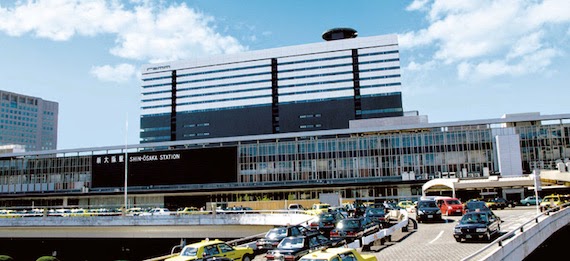Sumiyoshi Taisha was completed in A.D.211 at Sumiyoshi, Osaka. An event that Empress Jingu held a ceremony after invading Korea is the origin of it.
Because this shrine has set up Sumiyoshi San-Shin (three deities), a set of three sea-related deities, Sumiyoshi Taisha has been worshiped as the god of shipping since more than thousand years ago. Some have been advocating that those three deities symbolize the three stars of Orion's belt, typically arguing that its three shrines standing in a row were built in the image of Orion's belt. A fact that Orion has been a seamark for sailing backs the theory up.
Taiko-Bashi (drum bridge in Japanese) is one of the famous spots of Sumiyoshi-Taisha. The bridge is thought to have been built by Toyotomi Hideyori or Yodo-dono, a son and wife of Hideyosi as I mentioned in the article of Osaka Castlle, between the late 16th and early 17th. Since then, people have crossed the bridge for purifying their body and soul before entering the holy place -such as the main shrine- and facing the goodly entities.
Sumiyoshi Taisha is also known as the shrine representing the region where it stands; the Japanese regime between eleventh and twelfth century ordained representative shrines for every region, which became a traditional rule that is still going on today. Those shrines are given a title of Ichinomiya, the #1 shrine in Japanese.
By the way, Japan has two kinds of religious facility: temple and shrine. These facilities are like church for Christianity. For foreign travelers, they would seem to be the same kind of facility.
a typical temple
Strictly speaking, shrine and temple are classified into different type of facility from religious perspective, although most of Japanese people tend to lamp them as a single entity.
Shrine is the place for Japanese ancient worship in which people bereave that there are so many gods residing in every aspect of nature. Temple, on the other hand, is the place for Buddhism, which was transmitted to Japan from China in the sixth century.
However, those two religions were partially mixed while a long period of time. In fact, even Sumiyoshi Taisha, one of the most historical shrine, sometimes holds a workshop on buddhism, renting its space to external buddhists. Sumiyoshi Taisha nonetheless is clearly classified into the shrine type facility.
There are some different attributes between temple and shrine. For example, shrine -'Jinjya' in Japanese- has a gate called 'Tori'. Tori is usually colored in red, and that unique appearance evokes Japanese people a feeling of sacred things. For that reason, people have made use of the mark of Tori for preventing various wrongdoings, painting it on the walls of their houses, poles, and so on.
There are various types of Tori, in terms of color, material, size, design, and location. Right of the photo below is the Sumiyoshi Taisha's Tori.
Besides Tori, people working or living in those facilities are inevitably different. The staff of Temples are called 'Jyushoku', and they wear black mantles and have bald heads.
On the other hand, those who work in Shrines are called 'Shinshoku' or 'Shinkan'. They wear white-based mantles and generally have hairs.
Lastly, the name of facility is a decisive hint for distinguishing shrine and temple. Most of the names of temples usually include Ji or Dera in their ends, such as Horyu-ji, Ginkaku-ji, and Kurama-dera. On the other hand, most of the names of shrines include Taisha, Jinja, or Gu, such as Sumiyoshi-taisha, Izumo-taisha, Yasaka-jinja, Shimogamo-jinja, Tsurugaoka-hachimangu, and Meiji-jingu.
Shrine is called Jinja in Japan, and the english ward 'shrine' are not well known among Japanese people. Jinja is the place for Japanese ancient worship as I mentioned above, and it is called Shinto. Because it has been in Japan from a long time ago than buddhism, Shinto is well agreeing with minds of those who live in Japan. Simpleness, cleanness, and neatness, that is shown in Japanese traditional culture is conspicuously expressed in the world of Shinto. Those characteristics can be seen various Japanese traditional design and the origin of it is definitely seen in Shinto. Learning the Shinto can be a significant way for understanding Japanese culture.
Left:Japanese tea room Right:Japanese traditional garden














